Nokia NRS II Composite Exam
Last Update 6 days ago
Total Questions : 852
4A0-C01 is stable now with all latest exam questions are added 6 days ago. Just download our Full package and start your journey with Nokia NRS II Composite Exam certification. All these Nokia 4A0-C01 practice exam questions are real and verified by our Experts in the related industry fields.
Which of the following is defined by the following statement? All label mappings received from all peer LSRs are saved.
On a point-to-point link, two directly connected routers set different interface hello timeout values. Router R1 uses 15 seconds, while router R2 uses 30 seconds. What happens to the LDP adjacency?
Which of the following are the default settings for the Alcatel-Lucent 7750 SR when using LDP?
A targeted-LDP session may exist between directly connected or non-directly connected devices
The solicited node address for the destination node address of 2001:DB8::30A:216 4DFF:FE14:6CAE is:
Click on the exhibit.

Assuming point-to-point links, which of the following is TRUE?
Click on the exhibit.

A service provider is deploying a 6 over 4 tunnel to connect a customer's corporate IPv6 network to all devices at the branch office as shown in the exhibit.
Which command is used to create the route to the branch office network on PE1?
Click on the exhibit.
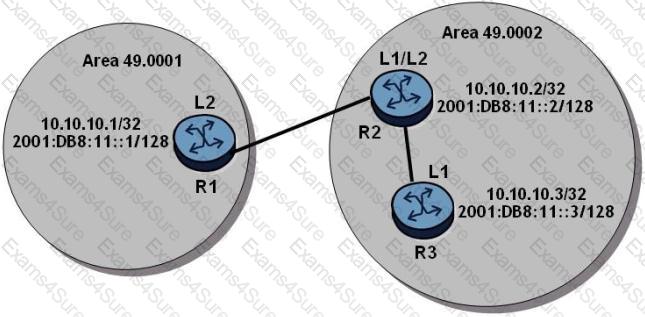
The routers have an established IS-IS L2 adjacency on which IPv4 system addresses are exchanged. An operator successfully configures multi-topology IS-IS routing so that the IPv6 system addresses are also exchanged between routers.
After IPv6 has been configured, which of the following is TRUE?
In an OSPF network, which of the following is NOT a result of manual summarization on an ABR?
An OSPF router receives an update in which the sequence number, age, and checksum are the same as the entry already in the topological database. What action does the router take?
Which of the following statements best describe MPLS fast reroute characteristics? (Choose two)
Which of the following statements is true when the implicit null is implemented?
Which of the following best describes the actions taken by an IS-IS router after it receives an LSP on a broadcast interface that is newer than the one in its database?
Which of the following devices receives labeled packets from the MPLS domain, removes the MPLS header, and forwards unlabeled packets outside the MPLS domain?
Which component of the Alcatel-Lucent 7750 SR is in charge of performing the longest prefix match lookup on packets that arrive on the physical interfaces?
Click the exhibit button.
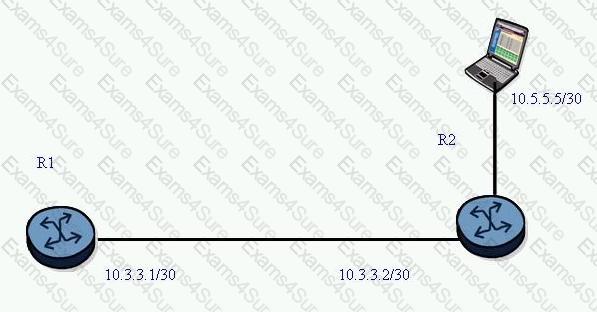
A static route is created on router R1 using the command "static-route 0.0.0.0/0 next-hop 10.3.3.2". What command can be used to test the static route on an Alcatel-Lucent 7750 SR?
Which of the following are functions of the MPLS control plane in a router? (Choose two)
How does an IS-IS router acknowledge the receipt of an IS-IS LSP on a point-to-point link?
Click on the exhibit button below:
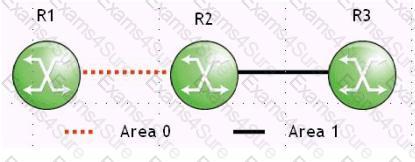
Consider the following:
- Router R2 is an ABR in OSPF Areas 0 and 1.
- Router R2 advertises the aggregate prefix 10.10.10.0/24 into Area 1.
- Router R1 in Area 0 generates LDP labels for FECs 10.10.102/31 and 10.10.10.4/31
Router R3 in Area 1 places these FECs in its LIB, but it does not place them in its LFI
B.
What can you do on router R3 to make it populate these labels in its LFIB?Which part of the NSAP address is used to indicate to the end system that a packet is to be processed by the router itself?
Click on the exhibit button below.
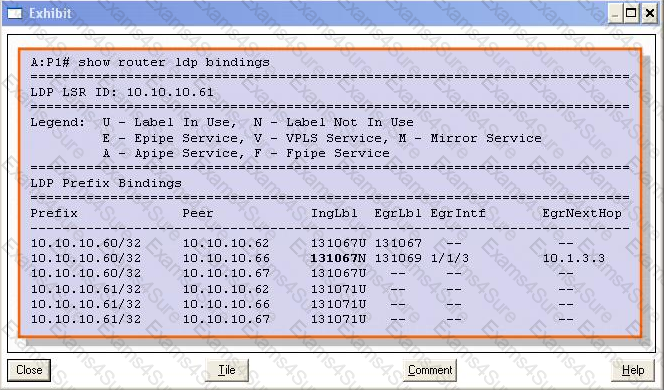
Consider the output shown; why is the label in bold font not in use?
Which of the following reservation styles can be used to prevent both the primary and secondary paths from booking resources on a common link?
Click on the exhibit.
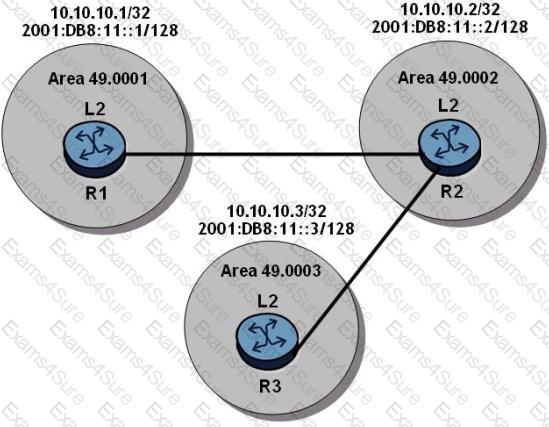
The routers have an established IS-IS L2 adjacency on which IPv4 system addresses are exchanged. An operator successfully configures multi-topology IS-IS routing so that the IPv6 system addresses are also exchanged between routers.
After IPv6 has been configured, which of the following is TRUE?
Which of the following best describes the actions after an IS-IS router receives on a broadcast interface, a newer LSP than the one in its database?
Which of the following cannot be used as a matching criterion in route policy statements?
In an OSPF environment, what must a router receive after it sends out an update?
Which of the following LSA types stay within an OSPF area, and are not flooded outside of the area? Choose two answers.
Click the exhibit button.
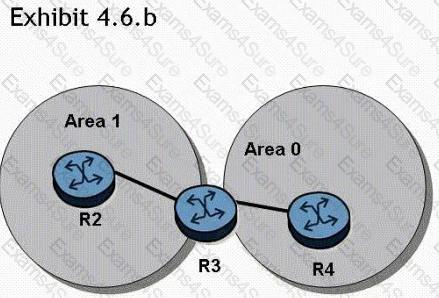
Which of the following would correctly configure routers R2, R3, and R4?
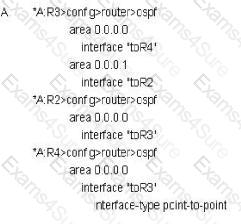
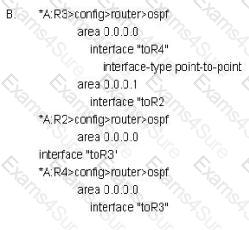
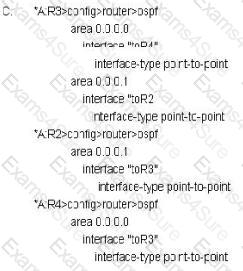
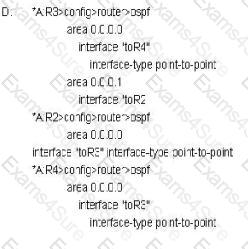
NSSA LSA packets are what type within an NSSA area, and are converted to what other type at the ABR?
In an OSPF Hello packet what fields must match all neighbor routers on the segment? (Choose 3)
Given the NSAP address of 49.0012.1234.1234.1234.00, what area does the IS-IS router reside in?
What are some of the characteristics of Alcatel-Lucent's implementation of non-stop routing? (Choose two)
Click the exhibit button.

Router R2 advertises the network 192.168.3.0/24 to router R1 via RIP.
How can router R1 ensure that it discards the route?
An Alcatel-Lucent 7750 SR receives a route via an IS-IS LSP with internal reach ability, and receives the same route via an OSPF type 5 LS
A.
If al protocol preferences are default, which route will be installed in the route table?An OSPF router receives an update in which the sequence number, age, and checksum are the same as the entry already in the topological database. What action is taken by the router?
What is the value of the protocol discriminator used to denote IS-IS protocol information?
When a router receives an IP packet, but does not find a match in the routing table for the destination IP address, what actions are performed by the router?
Click the exhibit button.
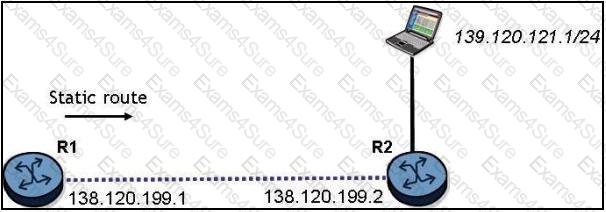
What is the command to configure a static route on the Alcatel-Lucent 7750 SR router R1 to reach the network behind router R2?
Click the exhibit button.
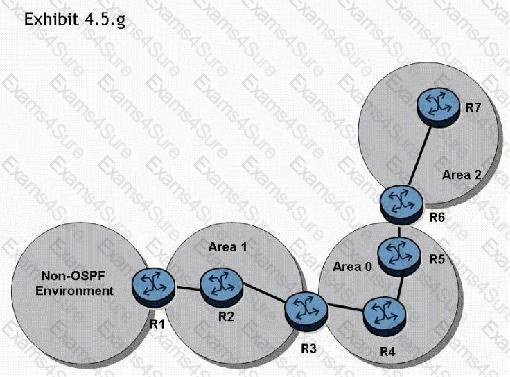
In the topology shown, router R1 is an ASBR configured to export external routes to OSP
F.
Assuming that there are no stub networks, which of the following statements regarding type 4 LSA generation is true?Click the exhibit button.
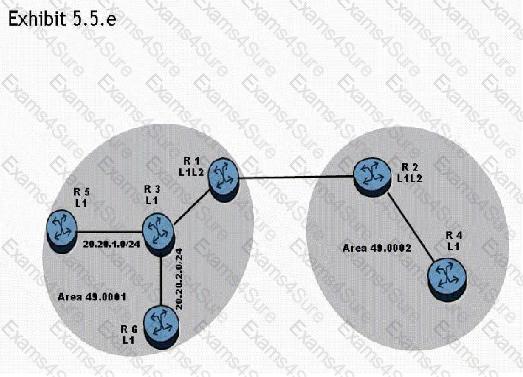
In the IS-IS network shown, router R1 has been configured to summarize network 20.20.1.0/24 and 20.20.2.0/24 as 20.20.0.0/16. Which router's routing table will be reduced compared to the routing table before the summarization?
Click the exhibit button.
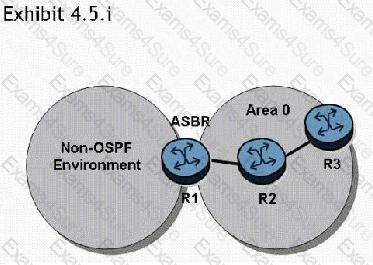
In the topology shown, router R1 is an ASBR configured to export external routes to OSP
F.
How many type 4 LSAs will be present in the network?Click the exhibit button.
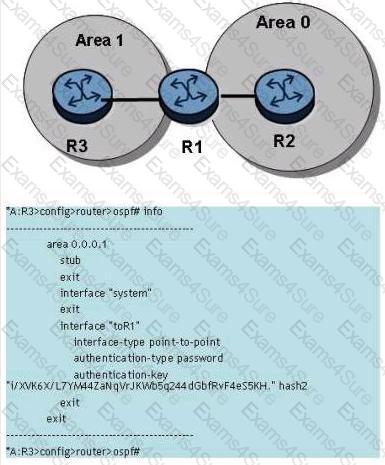
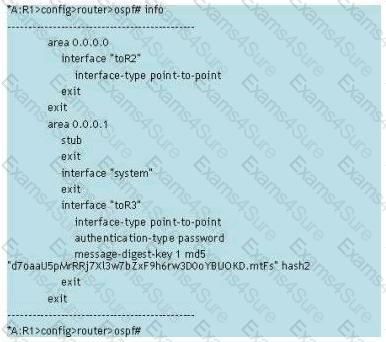
The OSPF adjacency between routers R3 and R1 is down. What is the problem?
Which of the following statements regarding area border routers in an OSPF network is true?
A router sets the E bit in the flags of its Type 1 LS
A.
What does this indicate?Which of the following best describes how IS-IS routers exchange updates on an Ethernet interface?
Click the exhibit button.
Which of the following statements best describes the format of data traffic sent from the PC to the server?
Which of the following types of network topologies are supported by IS-IS on the Alcatel-Lucent 7750 SR? Choose two answers.
Click the exhibit button.
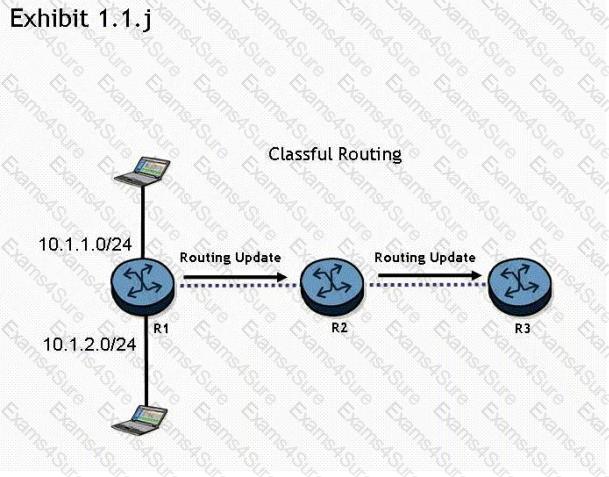
Routers R1 „ R2, and R3 are running a classful routing protocol between them. Assuming that router R1 advertises all directly connected networks, how will these networks be represented in router R3's routing table?
Which of the LSA types stay within an OSPF area and are not exported outside of the area? (Choose all that apply)
What acts as the tie breaker on an Alcatel-Lucent 7750 SR if the priorities are the same when IS-IS is electing a DIS?
What is wrong with the following filter configuration from an Alcatel-Lucent 7750 SR?
RTR-B# configure filter
RTR-B>config>filter# ip-filter 1 create
RTR-B>config>filter>ip-filter$ entry 1 create
RTR-B>config>filter>ip-filter>entry$ match src-ip 172.2.0.0/16
RTR-B>config>filter>ip-filter>entry# action drop
RTR-B# configure router interface toRTR-A
RTR-B>config>router>if# egress
RTR-B>config>router>if>egress# filter ip 1
What are the default Hello and Dead timer intervals for OSPF on the Alcatel-Lucent 7750 SR?
Click the exhibit.
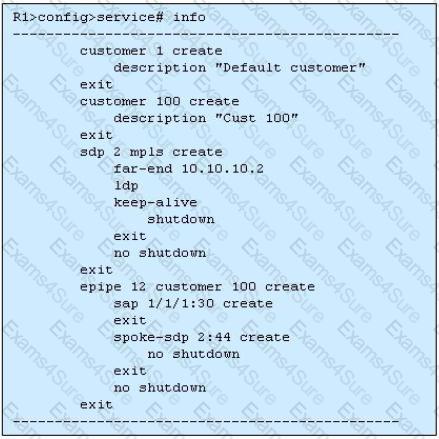
Based on the output shown, what is the value of the service's VC ID?
The SAP 1/1/1:2.3 receives an Ethernet frame with outer VLAN tag 5 and inner VLAN tag 3. Which of the following is TRUE?
Click the exhibit.
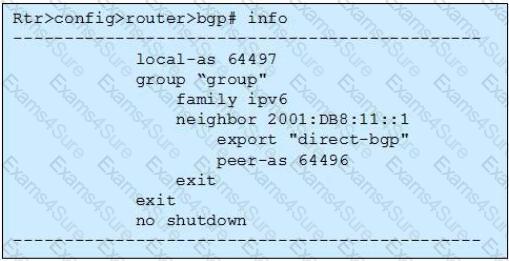
This output is from a router that is part of a 6VPE deployment using a VPRN. Which type of router would this configuration be found on?
Service tunnels and transport tunnels are bidirectional and only require the operator to configure the tunnel on one router.
Which of the following commands would be used to configure a new VPLS service that will use a default vc-id of 5 and a customer id of 4?
Click the exhibit.
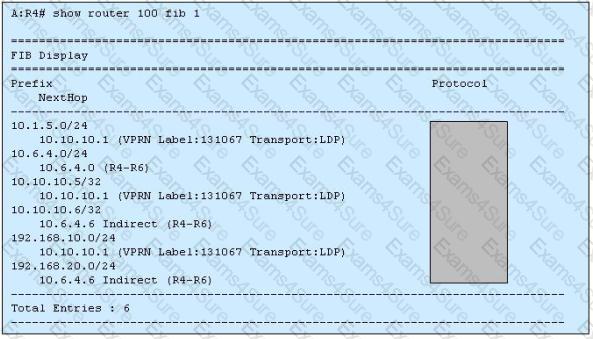
The output is from PE router R4 about VPRN service 100. How many prefixes have been learned from the MP-BGP protocol?
An SDP using MPLS encapsulation is configured for an E-pipe service. The network port on the Alcatel-Lucent 7750 SR used by the SDP has an MTU of 8000. What is the SDP path MTU?
Which of the following SAP encapsulations support multiple services on a port? (Choose 3)
An E-pipe is configured with a service MTU of 5000. What value will be derived for the VC-MTU?
Click the exhibit.
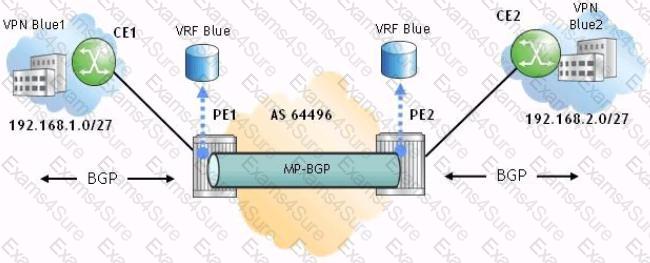
Assuming CE1 exports its system address using BGP, is a routing policy required on PE1 to advertise CE1's system address to PE2?
Which of the following statements best describes the flooding of traffic on a PE when traffic is received on a mesh SDP?
Click the exhibit.
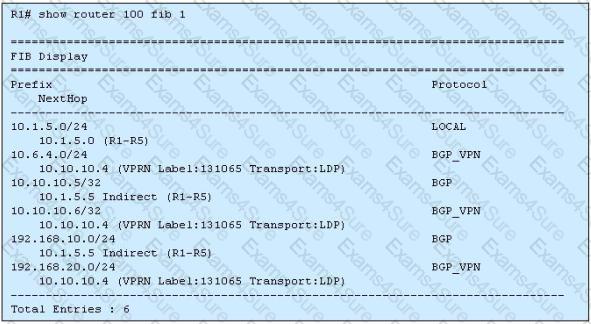
The output is from PE router R1 about VPRN service 100. From which protocol did router R1 learn the prefix 192.168.20.0/24?
Click the exhibit.
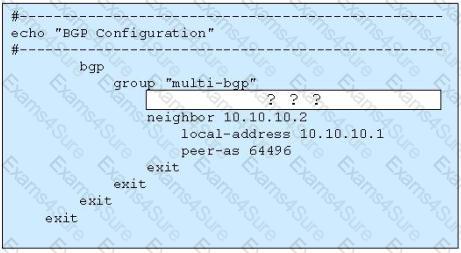
This PE is connected to an IPv4 core and is being configured to support 6VPE for a VPRN. Which of the following completes this section of the configuration?
Consider an E-pipe service configured with SAP 1/1/1:5 and SAP 1/1/1:6. If the SAP 1/1/1:5 accepts an ingress frame, which of the following is TRUE?
Click the exhibit. This output is from router R4. Service 333 is a VPLS. Why might the peer 10.10.10.1 have the same value for IngLbl and EgrLbl?
Which of the following about the Isp-ping command on the Alcatel-Lucent 7750 SR is FALSE?
Click the exhibit.
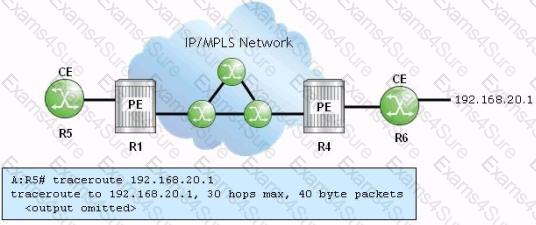
R1 and R4 are providing a VPRN for the CEs. Which of the following about the traceroute run on router R5 is TRUE?
When a tagged packet is received on a SAP configured with dot1q encapsulation, the VLAN tag must match the value configured on the SAP in order to be forwarded.
By default, what does the Alcatel-Lucent 7750 SR do when a frame with an unknown destination address is received in a VPLS?
Which of the following about transport tunnels used by services is FALSE?
Click the exhibit.
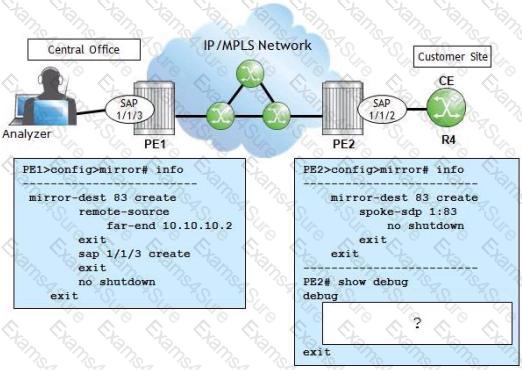
PE1 and PE2 are Alcatel-Lucent 7750 SRs. Which of the following is the missing configuration required on PE2 to complete the mirror?
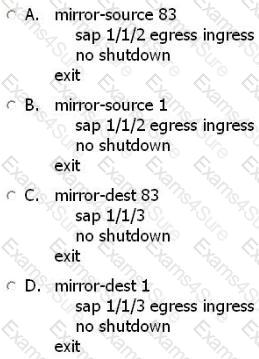
When using MP-BGP for an IPv4 VPRN service, what address family needs to be used for a PE-CE BGP session?
When configuring distributed services across a network, it is considered best practice to configure which of the following parameters as globally significant?
Click the exhibit.
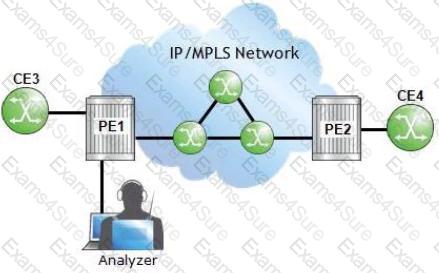
The operator at PE1 wants to analyze the traffic between CE4 and PE2. On an Alcatel-Lucent 7750 SR, which of the following is required as part of the configuration?
Which of the following best describes how the path-mlu is chosen for an SDP?
Click on the exhibit.
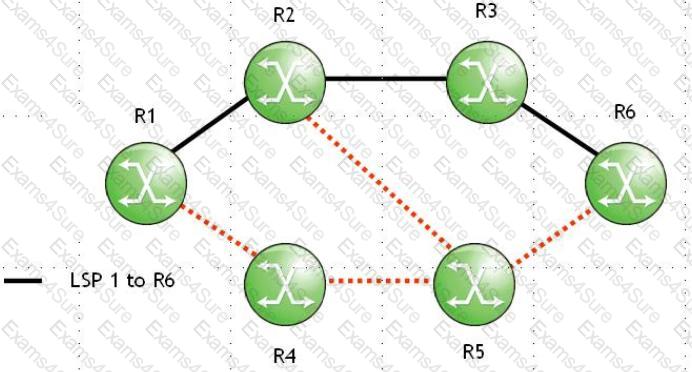
When router R1 forwards a PATH message to router R2, which of the following about the PATH message's IP header is TRUE?
Click on the exhibit button below.
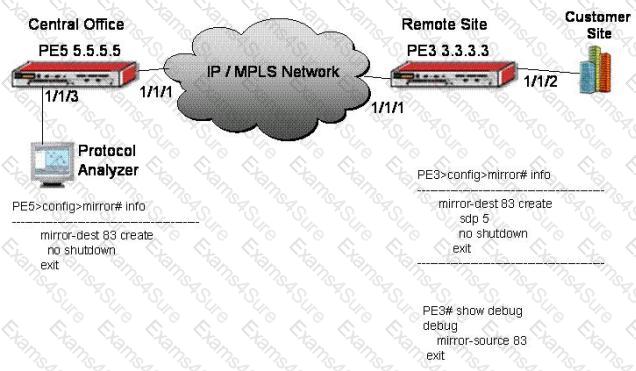
Assuming the customer only needs to monitor traffic from PE3 to the customer site, what two items are missing in the configuration of PE5, the Alcatel-Lucent 7750 Service Router in the Head Office? (Assume that the IP/MPLS network structure between the local and remote PEs is in place.)
Click on the exhibit button below.
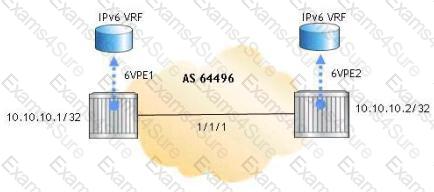
Which of the following is the correct configuration for an MP-BGP session on 6VPE1?
Click on the exhibit.
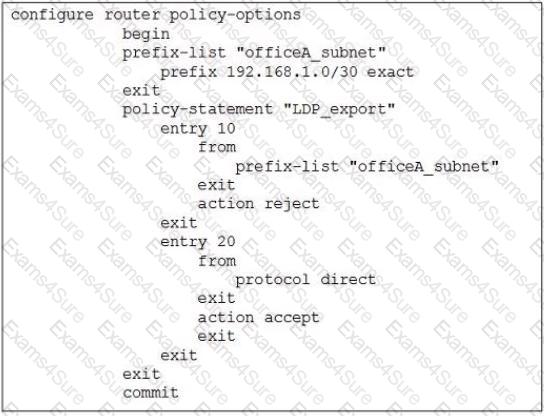
This policy is applied as an LDP export policy. In addition to the FECs learned from its neighbors, which FECs will appear in this router's LIB?
When configuring distributed services across a network, it is considered best practice to configure which of the following parameters as globally significant? (Choose 2)
Click on the exhibit.
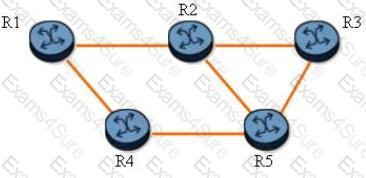
An LSP traverses the path R1-R2-R3. With one-to-one fast reroute enabled, which router becomes a DMP for the detour tunnels?
Which of the following statements is TRUE concerning route distinguishes on the 7750 SR?
Which of the following SAPs will forward tagged frames with an outer VLAN tag of 200? (Choose 3)
Which of the following about IS-IS Traffic Engineering on an Alcatel-Lucent 7750 SR is FALSE?
Click on the exhibit.
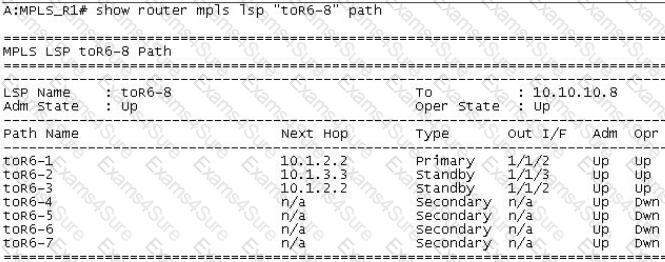
If the primary path fails, which backup LSP path will the head-end router pick first?
If an Alcatel-Lucent 7750 SR is an iLER operating in pipe mode, which of the following regarding the TC field (EXP bits) is TRUE?
Click on the exhibit.
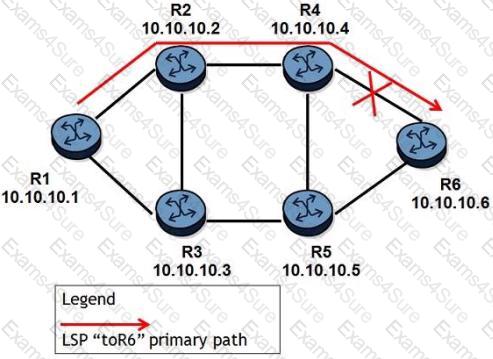
An LSP path is established on router R1 toward router R6. If the link between routers R4 and R6 goes down, which of the following is the quickest way for service recovery?
A network consists of 4 PE routers. A customer requires a VPLS service and has sites connected to each P
E.
Each site must have direct connectivity with all other sites. How many SDPs must be configured on each PE?Click on the exhibit.
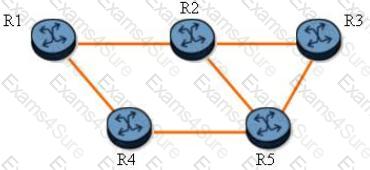
The path of a fast reroute protected LSP is R1-R2-R3. Which of the following about the protected LSP path is TRUE?
How does a DMP inform the downstream routers that it has merged detour tunnels?
Click on the exhibit.
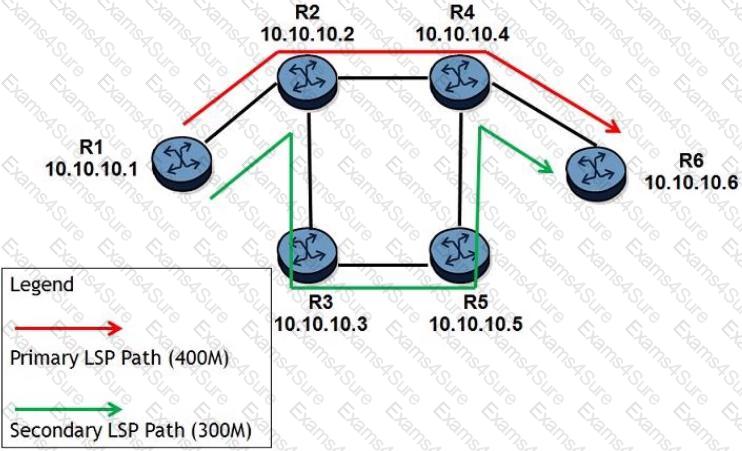
All links have 1Gbps unreserved bandwidth initially and Shared Explicit reservation style is used. After the LSP's primary and standby secondary paths are signaled, how much unreserved bandwidth is left on the links?
Click on the exhibit.
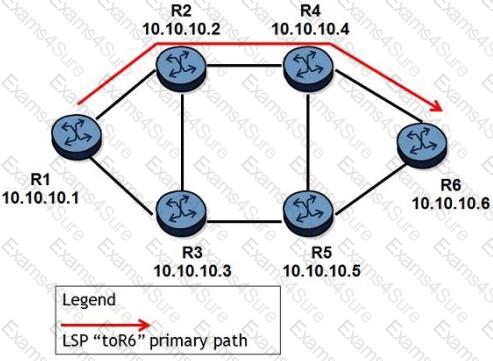
The LSP "toR6" is configured with a fully strict path on an Alcatel-Lucent 7750 SR. Which of the following configurations is required to enable fast reroute for this LSP?
Which of the following devices inspects the MPLS header in the received packet, and exchanges it for a new MPLS header?
Consider a device that uses per-platform label space; which of the following fields is NOT contained in the LFIB?
Click on the exhibit button below.

If CE1 and PE1 use BGP to exchange routing information and CE2 and PE2 use static routing to forward traffic to and from the VPRN, which of the following statements is considered TRUE?
Which of the following about the Link LDP discovery process on the Alcatel-Lucent 7750 SR is FALSE?
Which of the following devices assumes the active role during the establishment of an LDP session?
Which of the following is NOT a service offered on the Alcatel-Lucent 7750 SR?
Which of the following about the Alcatel-Lucent 7750 SR command "own Isp-trace" is FALSE?


TESTED 29 Apr 2024
Hi this is Romona Kearns from Holland and I would like to tell you that I passed my exam with the use of exams4sure dumps. I got same questions in my exam that I prepared from your test engine software. I will recommend your site to all my friends for sure.
Our all material is important and it will be handy for you. If you have short time for exam so, we are sure with the use of it you will pass it easily with good marks. If you will not pass so, you could feel free to claim your refund. We will give 100% money back guarantee if our customers will not satisfy with our products.